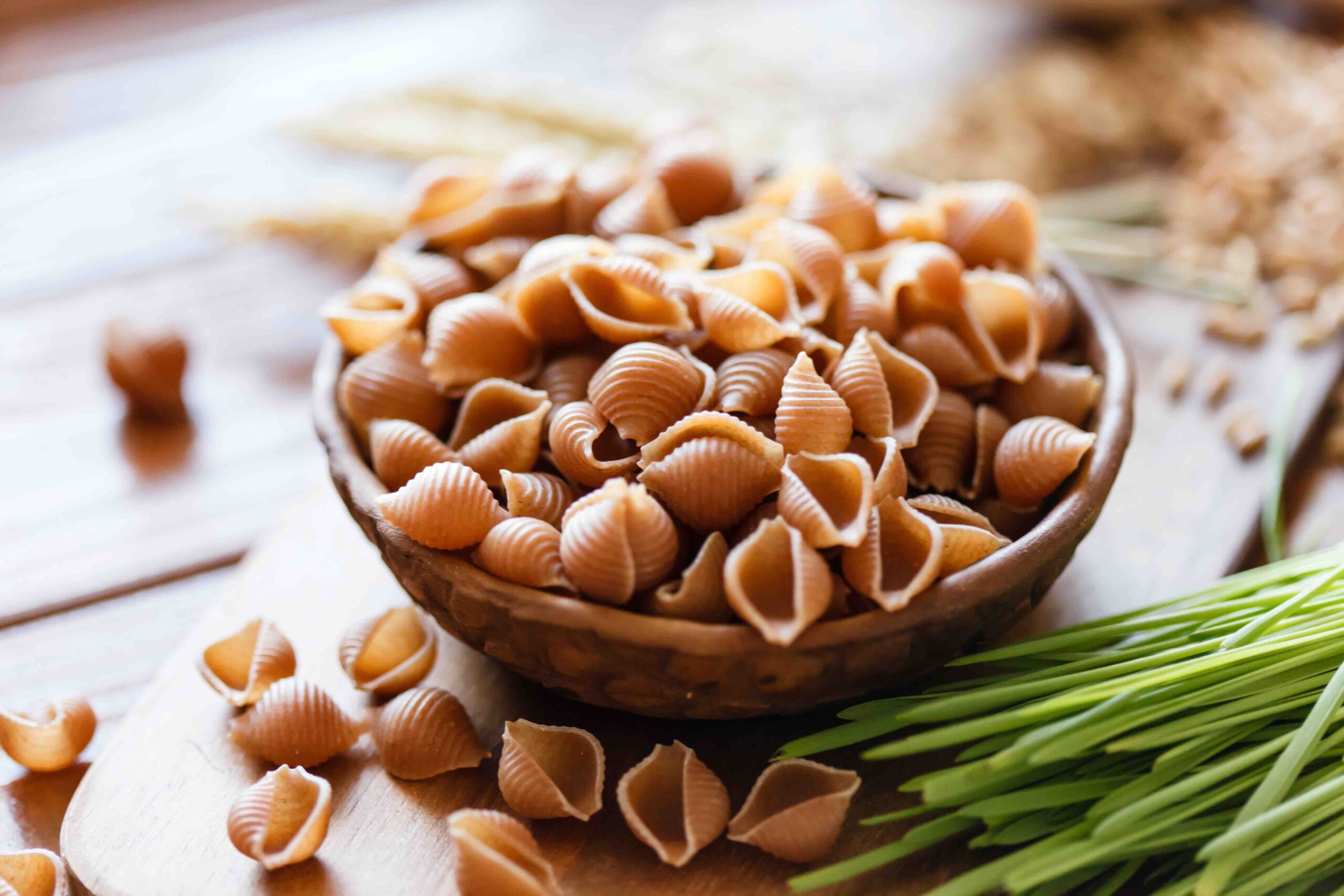How many calories are in pasta? And what are calories anyway? Calories is another word for the amount of energy you take in. In this blog tell you all about how many calories are in pasta and how much energy you take in when eating pasta.
How many calories are in pasta?
There are about 370 kilocalories in 100 grams of dried pasta. The amount of calories can vary from one type of pasta to another, but in normal pasta, made from durum wheat, the average amount of calories is about 370 kilocalories per 100 grams. This is equivalent to 1570 kilojoules.
The amount of calories in pasta can still vary considerably. It is therefore difficult to give a clear answer to the question “how many calories are in pasta?” because there are so many different types of pasta. That’s why we’ve done some thorough research, and we’ll tell you all about the calories in pasta…
What exactly are calories?
To understand how many calories are in pasta, it’s helpful to first have a good understanding of what calories are, and what they mean to your body.
When we talk about calories, we actually mean nothing more than the amount of energy you take in. So a calorie is a measure of the amount of energy.
The amount of energy is calculated in kilocalories. Kilocalories are often shortened to kcal. 1 kcal is 1000 calories.
In dried pasta there are about 370 kcal. So this written out would be 370,000 calories.
Because these are rather large numbers and the packages are often small, the nutritional value is almost always given in kcal.
In addition, it also looks a little less scary. The feeling is different when you see 370 kcal instead of 370,000 calories on the package!
What are calories for?
Your body needs energy for all physical processes and daily efforts.
It sounds logical that you need a lot of energy during exercise. But did you know that you also need energy during sleep? Just to keep breathing you consume an amount of energy.
You also need energy, for example, to keep your digestion going, your heart beating and all those other bodily functions running.
So you can simply say that you need energy or calories to stay alive. In addition, if you are very active for your job, or if you can often be found in the gym, you only need more energy.
So it’s important to get enough calories every day so that your body has more than enough energy to function properly.
How many calories are in pasta?
Pasta is a popular product and not without reason! Pasta is nutritious and full of good nutrients. Since our focus in this blog is on calories, we will focus on that now.
The amount of calories is always stated on the back of the package. This is in fact required by law, and so it should be on every package.
The calorie count is described per 100 grams of dried pasta.
So if you see on the back of the bag of pasta that there are 370 kcal in 100 grams of pasta, you know exactly where you stand.
Because there are so many types of pasta, it is difficult to give one specific number of calories. Most pasta shapes you find in the supermarket are all made from durum wheat.
There is no difference in the calories between the different pasta shapes. Therefore, we say that there is an average of 370 kcal in 100 grams of dried pasta.
How many calories are in whole wheat pasta?
The amount of calories in whole wheat pasta differs from the amount of calories in “normal” pasta. They are both pasta, but the amount of calories is different.
With whole wheat pasta, the skins of the wheat grain have not been removed during the grinding of the wheat. This makes the pasta darker in color and contains more fiber, for example.
Whole wheat pasta contains an average of about 350 kcal per 100 grams of pasta. So there is a difference in calories between normal pasta and wholemeal pasta.
It does not matter which form of whole wheat pasta you choose. If the pasta form is made of the same whole wheat, the amount of calories is almost the same. So you can just choose whole wheat spaghetti, whole wheat penne or whole wheat fettuccine, the amount of calories is the same.
How many calories are in spelt pasta?
The amount of calories in spelt pasta is also different from whole wheat or normal pasta. This is because spelt pasta is made from a different type of wheat. Spelt pasta is made from, you guessed it… spelt wheat!
Spelt pasta contains 357 kcal per 100 grams of pasta.
With spelt pasta it does not matter what form you choose. Whether you choose spelt spaghetti, spelt penne or spelt fettuccine, if it is made from the same spelt wheat, the amount of calories is almost the same.
How many calories per plate of pasta
The amount of calories in a plate of pasta depends on a number of factors. To begin with, the size of the portion of pasta. In other words, the amount of pasta per person that you weigh out before cooking it.
The ideal amount of pasta per person is 100 grams. We are, of course, talking about 100 grams of tolerated pasta here. In these 100 grams of tolerated pasta there are about 370 kcal.
The figures mentioned above just don’t say that much if you want to know how many calories you are taking in with a pasta dish. That depends much more on the sauce you prepare with the pasta.
After all, nobody only eats pasta. And certainly not uncooked pasta… In short, with about 370 kilocalories from uncooked pasta you know the basics, but that says nothing about the calories from a plate of pasta.
Every ingredient you add to your final pasta dish adds up to more calories. So if you want to know exactly how many calories are in a plate of pasta, you would have to weigh the amount of each ingredient.
Then you should calculate how many kcal per gram are present in each ingredient. So in the end you can calculate exactly how much energy you are taking in.
This is easier said than done. It is impossible for us to tell you how many calories are in a plate of pasta. What we can tell you is that there are 370 kcal in 100 grams of dried pasta.
Quantity of calories in cooked or uncooked pasta.
Because the amount of calories in dried pasta is always mentioned, it can be quite confusing how many calories there are in cooked pasta.
There are approximately 370 kcal per 100 grams in dried pasta. We have made this clear a number of times. But is there a difference in the number of calories when you remove that same amount of pasta from the boiling water?
The answer is simple: No, there is no difference in calories between uncooked or cooked pasta. Namely, you throw 100 grams of uncooked pasta into boiling water and let the pasta cook until tender. Water contains 0 calories so the boiling water adds nothing to the pasta.
As soon as you drain the pasta, the pasta has become heavier due to the absorption of water, but it has not gained any calories.
The confusing element is in the weight indication. If we talk about 100 grams of uncooked pasta we might be talking about 50 spaghetti strings. If we talk about 100 grams of cooked pasta, there are a lot fewer of them. Maybe as many as 25 instead of 50.
This is because during cooking, the strands of spaghetti soak up a lot of water. This makes each string a lot heavier. So there is a big difference in the amount of strands per 100 grams before and after cooking.
Since water contains no calories and spaghetti strands do, it goes without saying that the more spaghetti strands you cook, the more calories you will end up with on your plate.
This is why we always speak of 100 grams of uncooked pasta. That way it remains understandable and everyone speaks the same language. Just as easy!
How many calories a day?
Obsessing about calories, as sometimes happens, is nonsense. Everyone needs calories because everyone simply needs energy.
Your body doesn’t just need energy to go on a rampage in the gym; you need energy (and thus calories) for everything you do. To breathe, to grow, to heal. So for every effort, no matter how obvious it may seem.
What you have to watch out for is that you don’t take in much more energy than necessary, because the body stores it instead of burning it.
The Nutrition Centre teaches us that a man needs an average of 2,500 kilocalories and a woman 2,000 kilocalories.
There are also age factors involved, and the ‘calorie requirement’ is different for top athletes and pregnant women, for example. But on average these are the values that will not make you gain or lose weight.
A plate of pasta therefore contributes to a healthy lifestyle and this is the main reason why pasta is so popular. Of course, as with many things, eat in the right quantity.
If you stick to 100 grams of pasta per person, you can make sure you never eat too much pasta, and therefore not too many calories.
Calories in pasta vs. calories in potatoes or rice
In terms of calories, pasta is equivalent to potatoes or rice as part of the daily meal. How fat or lean you make these further, you fill in with the other components of your hot (or cold, with a pasta salad, for example) lunch or dinner.
If you want to keep the number of calories in your menu within limits in order to lose weight, then fortunately you do not have to leave pasta out. There are plenty of healthy pasta recipes to choose from!
Use the right pasta for your dish
Using the right pasta is important to bring out the flavors in your dish. You may not think about it, but pasta is the biggest part of your dish.
That’s why we advise you to always choose pasta of good quality. Invest an extra euro in good pasta, because you will definitely taste the difference.

